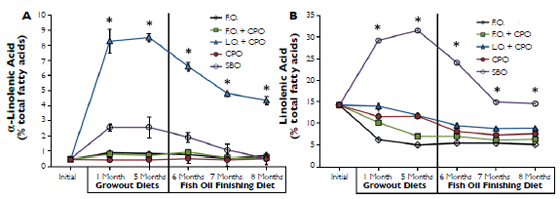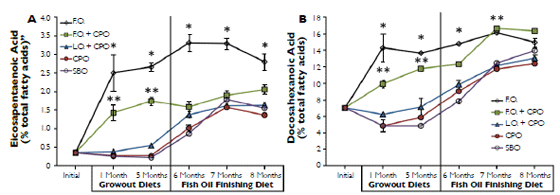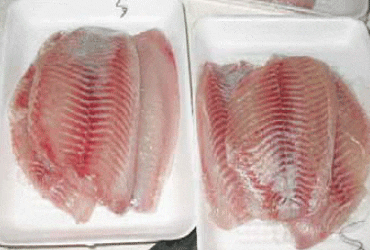The aquaculture industry is increasingly relying on vegetable oils in feed formulations since fish oil is becoming more expensive and in shorter supply. Vegetable oil is a cheaper lipid source that generally has little impact on the productivity of various fish species and also reduces dietary and fish tissue lipid peroxidation.
The latter is due to the fact that some vegetable oils contain relatively high amounts of natural vitamin E, a powerful antioxidant, as well as high saturated fatty acid (SFA) and monounsaturated fatty acid (MUFA) contents. These fatty acids are resistant to oxidation, which can translate to longer shelf life or storage duration.
On the other hand, fish oil alternatives are generally deficient in the health-promoting long-chain polyunsaturated fatty acids (LC-PUFAs), such as eicosapentaenoic acid (EPA, 20:5n3) and docosahexanoic acid (DHA, 22:6n3).
Fatty Acids In Tilapia
Although tilapia have some ability to bioconvert ?-linolenic acid (ALA, 18:3n3) and linoleic acid (L.A., 18:2n6) to LCPUFAs, the fatty acid composition of tilapia will generally mirror that of their diets. This characteristic can be exploited by utilizing a finishing diet, often containing the more expensive marine-based oils, to tailor the fatty acid composition of tilapia and thus improve their nutritive properties prior to harvest.
Accordingly, farmed tilapia can be fed vegetable oil-based diets throughout most of their growout culture and switched to a fish oil finishing diet just prior to harvesting. However, the efficacy of such a strategy can be dependent on the duration of providing these diets as well as prior feeding history, which can be highly species-specific.
Feeding Trial
In a study by the authors, the growth performance, feeding efficiency, fatty acid composition and lipid oxidative stability of tilapia with an initial weight of 19.8 g were assessed after five months of being fed five diets with different lipid sources. These diets were formulated to contain fish oil (F.O.), fish oil + crude palm oil (1:1) (F.O. + CPO), linseed oil + crude palm oil (1:1) (L.O. + CPO), crude palm oil (CPO) or soybean oil (SBO) at 10% total lipid.
The F.O. diet was highest in LC-PUFAs, followed by the F.O. + CPO diet. The L.O. + CPO diet and SBO diet contained high amounts of ALA and L.A., respectively, while the CPO diet contained a high MUFA and SFA content. Danish fishmeal and soybean meal were used as protein sources at a 2:3 ratio.
After five months on these diets, tilapia were switched to a fish oil-based finishing diet, and the fatty acid composition and lipid oxidative stability were measured each month for three months.

Results
The growth performance and feeding efficiencies were slightly better for tilapia fed the fish oil-based diets after five months, although no significant differences were detected. Moreover, survival, carcass/fillet yield and various body indices were similar among all dietary treatments. As expected, the fatty acid compositions of the tilapia fillets were similar to those of the diets.
Lipid oxidative stability was substantially greater in tilapia fed the vegetable oil-based diets, particularly the SBO and CPO diets. These diets also led to the highest deposition of SFA and MUFA content, respectively, as well as vitamin E. While oxidative stability gradually decreased over three months when tilapia were switched to a fish oil finishing diet, this was still significantly higher for those previously fed the SBO or CPO diet.
Over three months of tilapia fed the finishing diet, the fillet lipid ALA and L.A. content rapidly decreased (Figures 1A, 1B), but still remained high for tilapia previously fed the L.O. + CPO or SBO diet, respectively. The omega-3 LC-PUFA fatty acids, including EPA and DHA, rapidly increased (Figures 2A, 2B). Although the EPA content was still significantly lower after three months than for tilapia fed the F.O. diet throughout, DHA content was similar among all dietary treatments after three months on the finishing diet.
Finishing Diet Efficacy
Despite the markedly different fatty acid compositions of the tested diets, tilapia productivity was not significantly affected by the various dietary lipid sources over the course of five months from stocking to near marketable size. This indicated that a reduced reliance on marine-based oils can substantially lower feeding costs during tilapia growout.
Due to the higher deposition of vitamin E and lower LCPUFA content, fillet lipid oxidative stability was greater for tilapia fed the vegetable-oil based diets. However, in terms of the fatty acid composition, this can be less healthy for human consumers due to the decrease in the beneficial omega-3 fatty acids in tilapia fillets.
The use of a fish oil-based finishing diet was shown to be effective in boosting beneficial fatty acids in tilapia, since there was a significant increase in the LC-PUFA content of their fillets, regardless of prior feeding history. However, tilapia previously fed the CPO + F.O. diet had the highest LC-PUFA content after three months, likely due in part to the higher LCPUFA content in this diet.
The other vegetable oil-based diets led to similar deposition rates of EPA and DHA, while ALA and L.A. were the most persistent fatty acids in tilapia previously fed the L.O. + CPO and SBO diets, respectively. Interestingly, lipid oxidative stability remained significantly higher for tilapia previously fed the SBO or CPO diet than those fed the F.O. diet throughout.
Perspectives
Although the tested dietary vegetable oils had little to no effect on tilapia productivity, the substantially lower LC-PUFA content and n-3:n-6 ratios may give tilapia a poor public image in terms of human health. The use of a fish oil-based finishing diet can be an effective strategy to prevent this from occurring.
When switched to the finishing diet, it was shown that prior feeding history had little impact on LC-PUFA deposition, although the n-3:n-6 ratios of the final product were substantially different – ranging from 2.76 to 1.08 for tilapia previously fed the CPO + F.O. diet and the SBO diet, respectively.

Since researchers and nutritionists often use LC-PUFA content but also n-3:n-6 fatty acid ratios in assessing the nutritive values of food, prior feeding history should be taken into account. On the other hand, although the LC-PUFA and n-3:n-6 ratios were still significantly lower than for tilapia fed the fish oil diet throughout, these values were similar to examples of wild tilapia.
As such, since it is inevitable that fish oil in tilapia diets will be used in lower amounts, to maintain tilapia as a healthy product for human consumption, the use of finishing diets can be an effective strategy. Indeed, the use of dietary vegetable oils during the growout of tilapia followed by feeding finishing diets can offer a good balance for cost effectiveness, fillet oxidative stability and beneficial fatty acids for human consumers.

April 2013




